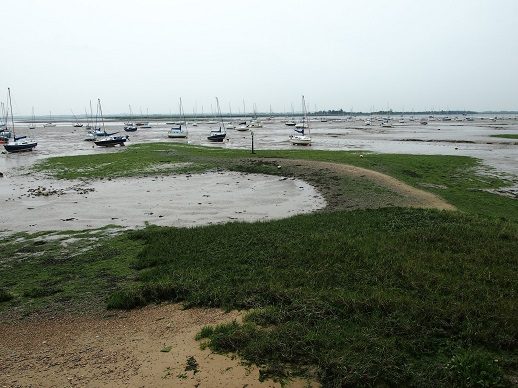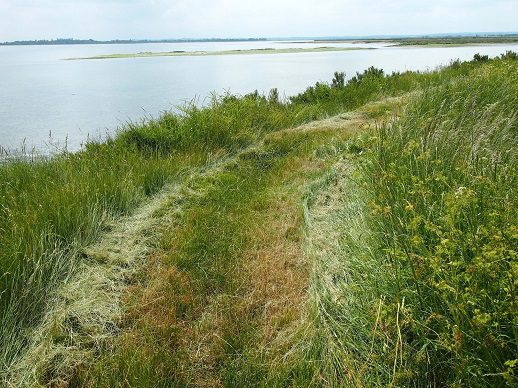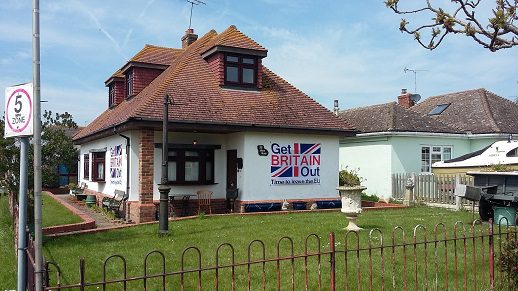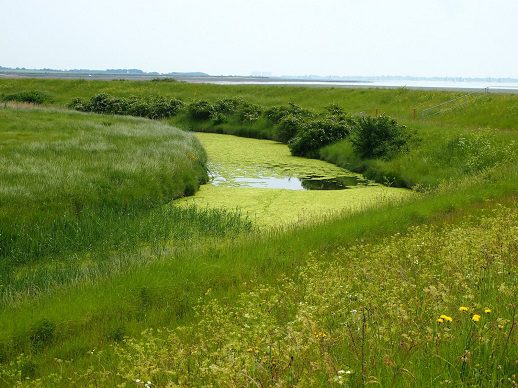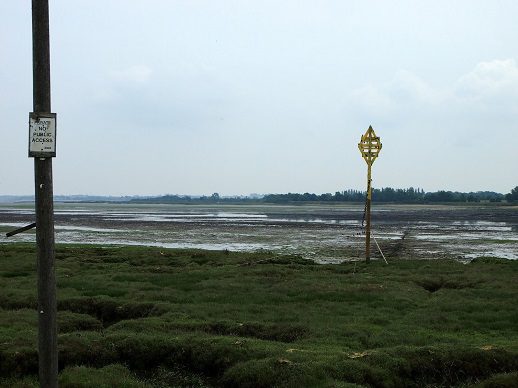Words and images by Tom Bolton
We had returned to Maldon only a couple of weeks after our previous visit, keen to explore the low-lying north bank land, apparently empty of any significant habitation, that we had observed on the horizon as we walked along the south bank of the Blackwater Estuary. Maldon lay at the confluence of the River Blackwater and the River Chelmer, both of which flowed only in Essex from source to sea. Maldon, a town with a Roman past and a Saxon past, had seemed connected to national origins in a fashion particular to the eastern edge of England, where river estuaries gaped, inviting visitors from across the North Sea to anchor, raid and remain.
Maldon, with its unique triangular church tower – the only one in England – had been designed and constructed long ago to a plan that could no longer be understood. The church had belonged to Beeleigh Abbey, on the outskirts of Maldon, which was built in 1180 for the Norbertine monks, founded in Northern France by St. Norbert and known as the White Canons. The Abbey had been a pilgrimage site, home to the heart of St. Roger Niger, a 12th century Bishop of London with Essex connections whose burial, it was said, had caused an eclipse of the sun. A substantial medieval house survived, Beeleigh Abbey House, which had been the home of bookshop owner Christina Foyle until her death in 1999. Employees at her chaotic Charing Cross emporium were invited for nerve-wracking weekend visits to Beeleigh, where they were inspected.
Walking out of Maldon, we crossed the Blackwater and then the Chelmer and Blackwater Canal, taking the towpath back towards salt water. Heybridge was the industrial end of Maldon, a separate village which had consented to the canal that was beneath the aspirations of 18th century Maldon. It had the rough end of the deal. The dominant Bentall’s agricultural machinery factory beside the river had closed at the end of the 1980s. Its name now belonged to a shopping centre with an Asda in distinctive 1980s out-of-town style, with pitched roof and non-functional clock tower. It looked like a snide parody of the 18th century grandeur along Maldon High Street.
The route down to the estuary led along the final stretch of the Chelmer and Blackwater Navigation, built to connect Chelmsford, the Essex county town, to the sea. It stopped taking commercial traffic in 1972, and the gravel pits at its mouth had become a combination of lakes and new, raw red brick houses. The route had been well-used for materials imported from across the sea and along the coast. It was also a route out of the country, to the continent. In H.G. Wells’ War of the Worlds, the narrator’s relatives had escaped the Martians on a boat from Maldon to Ostend. In scenes prefiguring the Dunkirk evacuation, boats of all sizes had swarmed along the Essex coast and filled the Blackwater Estuary: “steam launches from the Thames, yachts, electric boats… ships of large burden, a multitude of filthy colliers, trim merchantmen, cattle ships, passenger boats, petroleum tanks, ocean tramps, an old white transport even, neat white and grey liners from Southampton and Hamburg”. Off the estuary the narrator’s brother had witnessed the destruction by Martian heat rays of the Navy ironclad, Thunder Child.
At low tide the estuary at Maldon was an oozing landscape of channel-riven mud, looking ready to swallow a grown man whole. Maldon had embraced its slimy setting and founded a new tradition, the Mud Race. Held once a year, it began in the early 1970s as a stumble and swim through the wide mud flats at the mouth of the Blackwater, where a barrel of beer waited on the opposite bank. Despite the disappearance of the beer the race had continued, as the town’s population seized a rare chance to return to become one with their surroundings.
Northey Island, strategically placed in the mouth of the Blackwater, was owned by Sir Norman Angell before the Second World War. Angell, who designed the only house on the island, was a journalist who became a Labour MP, a political theorist and an international peace campaigner. He roamed the world, working as a cowboy amongst other precarious occupations in 1890s California, and as a journalist on the continent, becoming Paris Editor for the Daily Mail. He received the Nobel Peace Prize in 1933, the only person to be honoured for a book. The Grand Illusion, published in 1910, had proposed a theory of the end of war. It explored the idea that the financial and business links between major powers meant that war was no longer in the interests of any country. The theory was proved deeply wrong – not once, but twice – as Europe descended into two world wars. Angell died in the late 1960s, having witnessed successive international failures to place peace above the nation state.
Out on the Blackwater, a slab of land had separated itself from the horizon and was moving closer. This was Osea Island, larger and more intact than Northey Island, having retained its sea wall. Osea was one of the last remaining habitats of the raven in South East England, where it was last seen in the late 19th century. Ravens had been hunted by farmers to protect their lambs. The Essex Field Club had reported in 1890 that ravens had been seen on Osea Island, but that “the Raven is already trembling on the very verge of extinction in Essex”. At the start of the 2010s ravens were sighted once more in Norfolk for the first time in 120 years, having spread slowly back from their redoubts in the north and west, and it had been suggested that they could eventually return to the marshes.
Osea Island could only be reached from the far bank via a tidal causeway called The Stumble, but casual visitors were not welcome. While Northey was now owned by the National Trust, Osea was a private island, and had been bought in 2000 by Sugababes producer Nigel Frieda. It was best known as the home of an alcohol and drug rehabilitation centre, a retreat for the wealthy and famous including, inevitably, Amy Winehouse. The centre had been set up in 1903 by brewery heir Frederick Charrington, who had abandoned the family business and become a temperance campaigner after witnessing a man beating his wife as she begged him to come home, outside a Charrington’s pub.
Outside Goldhanger a distant crowd of Eastern European fruit pickers worked the fields, wearing colourful headscarves. Travelling across the continent for seasonal work now disregarded by the natives, they were picking strawberries. Bounds Farms at Goldhanger was the location for the specialist strawberry fields of Wilkin and Sons, where the tiny, prized Little Scarlet fruit was grown. The 2016 title of Fastest Picker in the Tiptree Strawberry Race at Goldhanger had gone to a Polish picker, with a Romanian as runner up.
Fish Street led into Goldhanger village from the sea, where and entire house was decorated with Get Britain Out posters, a level of open hostility to continental connections that intrigued and alarmed us. The church had been built using stones from a Roman building thought to have stood on Fish Street in the 400s. The church contained intricate 14th century carved bosses, on which great newts lurked in tangle of leaves and branches. In 1865, Lewis Carroll had stayed at the Rectory where he was reported to have heard a comical story which claimed that treacle pits had formed in Goldhanger after consignments of sugar beet had been left to dissolve. The Alice in Wonderland treacle mines may have been the result.
Past Goldhanger, the extraordinary decoy pond marked on pre-war maps had vanished. It had been shaped liked an eight-armed wheel of fire, paused in a full anti-clockwise spin, trailing sparks. It was filled and its field ploughed during the Second World War, but aerial photographs reveal a dark after-image burned into the corn. While this was the most elaborate, decoy ponds once lined this bank of the estuary, providing duck, teal, widgeon and other waterfowl for sale in the markets of London. The ponds had narrow entrances and were screened so that when they were full of birds, men and dogs could creep around and net the entrance, trapping the birds for easy shooting. The Blackwater was known for its decoy ponds in the 18th and 19th centuries, and for its punt guns. These fearsome weapons were mounted on flat bottomed boats which could glide among the reeds towards the feeding grounds for flocks of water birds. In 1904 Harry Handley of Maldon recalled killing 432 dunlin with a single shot, while punting at Stansgate Abbey Farm, on the south bank of the Blackwater. This scarcely seemed credible, but several other reports that punt-gunners had often killed hundreds of birds with a single discharge of their weapons on the Blackwater and Dengie marshes.
Hay fever season had arrived, and on the north shore of the estuary the sea wall was a tangle of long grass. Pollen drifted in the air, coating our legs as we brushed through. Jo was suffering, and she had begun to find it hard to see through swollen eyes. The landscape was turning against us, and we were soon keen to reach the end of our journey and escape the grassland miasma. However, there were several miles still to go before any kind of settlement.
Nine ‘red hills’ were marked along our route, piled remnants of the clay vessels used in Bronze Age salt pan. More than 2,000 years later Essex was still known for its sea salt, harvested from the saltings around Maldon and sold across the world by the Maldon Salt Company. At home in the 1980s the Maldon box, with its taste of the tides, had been especially reserved for sprinkling on baked potatoes.
The landscape, so evidently marked by the long dead, appealed to ghost story master M.R. James. While his more famous stories are located further along the coast in Suffolk, The Rose Garden was set in a fictional village outside Maldon. Mrs Anstruther, planning a rose garden, had chosen a spot where people were unable to explain why they felt “the most intense anxiety, oppression and hopelessness.” Subsequent events give her such a severe shock that it is “decided that she must spend the winter abroad”.
The occasional bus link to Witham called us inland to Tollesbury, a mile north. If we missed it, we would have to negotiate our way off the fens, and the terms demanded for safe passage would undoubtedly be high. As we turned inland, we took a last look over the Blackwater to our starting point, the twin Magnox reactors at Bradwell, guardians of the river mouth. The studied greyness of these colossal concrete chambers highlighted rather than concealing them, as they appeared to hover between absence and presence. Their unstable connection to the physical realm matched that of the channels around them, flooding inland to realign the coastal map and immediately withdrawing again. The plant had drawn huge volumes of water from the mouth of the Blackwater to cool its reactor core, becoming governed by the tides and dependent on phases of the moon, ancient and modern technologies operating in sequential rhythm.
We had read a story about Bradwell, a strange theft with echoes of Kiss Me Deadly, the 1955 Robert Aldrich film noir fuelled by a stolen briefcase with terrifying, glowing contents. On 19th November 1966 police had stopped a van on the North Circular Road in London to check its steering. The driver had been revealed as Dennis Hadley, a decorator working at Bradwell Nuclear Power Station, and the van contained twenty uranium fuel rods. Hadley was arrested, and it emerged that he and a rigger called Harold Sneath, from Maylandsea on the Dengie, had stolen the rods from the Bradwell store. Hadley was on his way to sell them to a contact for scrap. Despite the disastrous consequences, avoided only by chance, the two had been fined £100 each on the basis that they had no idea what they were doing.
Magnox reactors were now only in operation in North Korea. Bradwell had last generated electricity in 2002, and the decommissioning process had been underway ever since, scheduled for completion in 2083. Bradwell lay dormant, for now, but it seemed unlikely that any government would pass up the chance to reuse the site for nuclear generation, if it could square the enormous costs.
Our route back to Liverpool Street returned us to an urban culture that we understood, only a short journey from a country that was becoming less familiar as the days ticked down towards the EU Referendum. By the time we came out to the Essex coast again, the future would have become much less certain than we had imagined or expected.
P.S. Thanks to Hal Johnson for pointing out that my explanation of men and dogs creeping behind the ducks to net them misses the point. In fact, dogs were trained to lure ducks into the decoy net by showing themselves at a gap, waiting until the ducks approached to investigate, then appearing again at a gap further in. Sometimes ducks were lured in with a trail of grain. Either way, the natural curiosity of the duck was its downfall.
*
See previous Edge Walking posts here.
Tom Bolton on Caught by the River/on Twitter
